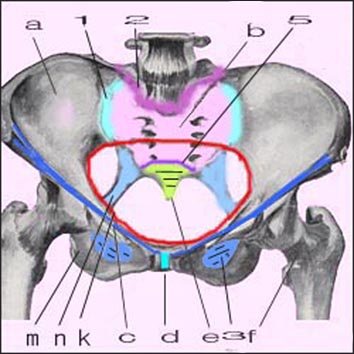
Copyright ⓒ 2014 John Sangwon Lee, MD., FAAP
Pubic symphysis dysfunction during pegnancy 임신 중 치골결합(두덩 결합) 기능부전

Combined with various ligaments in the female pelvis and pelvis a-iliac bone, b-sacrum, e-coccyx, f-femur, m-Coccyx bone, n-sacral ligament, c-cooper ligament, 3-closing membrane, 1-sacral iliac joint, 2-lumbar sacral joint, 5- Sacral coccyx joint, d-pubic joint, k-pelvic entrance References-Principles and Practice of Obstetrics, De Lee-Greenhill, 9th Edition, Saunders
![]()
The pelvis has sacrum and coccyx on the backside, iliac bones on both sides of the backside, and is composed of pubis on the anterior and lateral sides, and is connected to the lumbar spine above by the femur.
The pubis on both sides is connected by a pubis joint. This pubic bond is formed by ligaments and the like.
When it is close to delivery, a hormone called Relaxin is secreted, and under the influence of that hormone, the pubic bond is loosened, and the various types of ligaments and settlement tissues that form the pelvis are loosened.
So, the joint joints in the pelvis loosen and open up properly for the baby to be born. So, the size of the birth canal is also appropriate to deliver the baby through the birth canal. The pelvis contains a fetus that has grown to full term.
When supporting a large fetus in full-term like this, the pelvis may hurt. The pelvis also serves to support the upper body of the pregnant woman.
Even for that reason, the entire pelvis can hurt. This phenomenon is called pubic bond (head bond) dysfunction.
Pubic dysfunction or cranial dysfunction can develop more severely after swimming or working while sitting in one place for a long time. If there is pubic joint insufficiency, the following symptoms can occur.
Pain in the pubis, the lower back in the sacrum and coccyx, and the groin, buttocks, and femurs can hurt. When you apply a lot of power to one leg, it hurts more, and the pelvis may feel as if open, and sometimes you may not be able to walk well. There is no special effect because it is a part of pregnancy’s natural phenomena that are caused by the influence of hormones such as relaxin during pregnancy.
However, pregnant women refrain from lifting heavy objects. When getting dressed or riding in a car, move your hips carefully and appropriately, then move other body parts, and so on.
In severe cases, treat with pain relievers according to the doctor’s prescription. Copyright ⓒ 2014 John Sangwon Lee, MD., FAAP
“부모도 반의사가 되어야 한다”-본 사이트의 내용은 여러분들의 의사로부터 얻은 정보와 진료를 대신할 수 없습니다.
“The information contained in this publication should not be used as a substitute for the medical care and advice of your doctor. There may be variations in treatment that your doctor may recommend based on individual facts and circumstances.
“Parental education is the best medicine.“